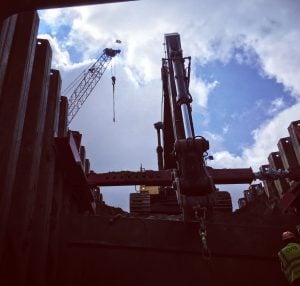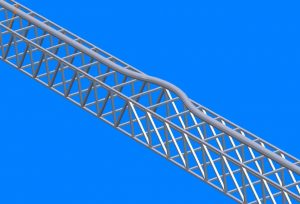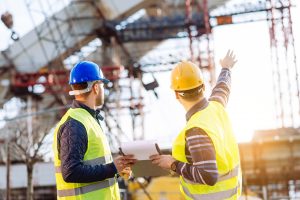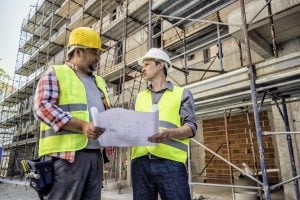Moving vertically on a construction project can be a challenge. While stairs are normally available, it doesn’t make a whole lot of sense to use those to climb 50 stories unless you are interested in a lot of exercise! Consequently hoists, elevators and lifts are frequently used to transport workers and materials between the various floors of buildings under construction. In fact, rare is the project that doesn’t have some type of hoist for moving people and material vertically.
In the interest of making jobsites safe, the American National Standards Institute, ANSI, has developed numerous standards for use on jobsites, including standards for personnel hoists (elevators). One of the standards which address the machines that move people vertically at construction sites is ANSI/ASSE A10.4-2007: Personnel Hoists and Employee Elevators on Construction and Demolition Sites. Another standard is ANSI/SIA A92.10-2009: Transport Platforms. Both of these standards address similar vertical transportation issues but in different ways.
“Personnel hoists and employee elevators” are utilized as the general carrier for workers on jobsites who want to travel between floors while “transport platforms” are more specific in their use. Although each can be used to transport workers, a hoist is more adaptable to fast movement between floors where the interest is to get from one floor to another while a transport platform is more adaptable to a specific work environment. In fact, the scope of each standard explains the difference. A92.10 applies to “Transport Platforms that are primarily used as a tool of the trade to vertically transport authorized persons, along with materials and necessary tools, to various access levels on a building or structure for construction, renovation, maintenance or other types of work.” [A92.10-2009: 1.1] On the other hand, A10.4 “applies to the design, construction, installation, operation, inspection, testing, maintenance, alterations and repair of hoists and elevators that (1) are not an integral part of building, (2) are installed inside or outside building or structures during construction, alteration, demolition or operations and (3) are used to raise and lower workers and other personnel connected with or related to the structure.” [A10.4-2007: 1.1.1]
Although these scopes may appear similar, there are subtle differences. In the simplest explanation, a transport platform is more portable than a personnel hoist while a personnel hoist is more like a permanent elevator in a building. The personnel hoist has doors, gates, cages, enclosures, counterweights and other devices not unlike a normal building passenger elevator while the transport platform is a stripped down model. That is not to say that a transport platform is more hazardous; it’s just not as robust as a personnel hoist.
Each standard has specific requirements regarding the design and fabrication of the machine. For example, wind loads, live loads, dynamic loads, overturning forces and inertia forces must be considered by the manufacturer. Of particular concern for the erector is the connection of the machine to the building since improper and/or inadequate connections will lead to catastrophic failure of the entire system. In other words, the erector better know what he/she is doing!
Keeping in mind that transport platforms are more portable than personnel hoists, the inspection criteria is different for each. Transport platforms are treated more like scaffolding, that is, a temporary structure. It is expected that the transport platform operator will visually inspect the machine each day before use. The user shall “check the operating devices, brakes, emergency stops, the condition of all trailing cables, travel limit switches, guardrails, structural connecting mast ties, cables, guide rollers, and information plates, etc.” [A92.10-2009: 5.1.2.9] Load test frequency for transport platforms is determined by applicable regulations (local and national) and the manufacturer. For personnel hoists, “periodic inspections and tests of hoists shall be made at intervals not to exceed three months.” [A10.4-2007: 26.4.3] Since personnel hoists are more complex and sophisticated in their operation than transport platforms, these inspections are more thorough than the transport platform inspections normally are.
As with all machinery, operators are expected to be trained. For transport platforms, operators must be trained in all facets of the machine, including inspection, safety requirements, stability, allowable loads, the purpose of placards and decals, to name a few. The obligations of the operator is not to be taken lightly as he is the individual who will ensure the safe use of the platform. Simply stated, this means that if you are not the operator, you are not allowed to operate the platform. As a rider, you get to ride, not to operate.
For personnel hoists, they shall be “operated by a competent and authorized operator.” [A10.4-2007: 30.1] Furthermore, the operators shall be “knowledgeable and capable of performing the duties outlined in the maintenance, operating and inspection manuals and are capable or recording such activity in their log.” [A10.4-2007: 30.3] Normally, the personnel hoist operator is a designated driver who has no other duties while the transport platform operator may be doing other work once the transport platform arrives at the work location.
In summary, a personnel hoist is a sophisticated machine, similar in design and operation to a building elevator while a transport platform is a device that takes several workers to a work location with their tools and material. The personnel hoist is truly an elevator, albeit a temporary one that will be removed when the project is completed, while the transport platform is much more temporary by being easier to erect, dismantle, operate and use; in other words it is more like a scaffold than the personnel hoist.














